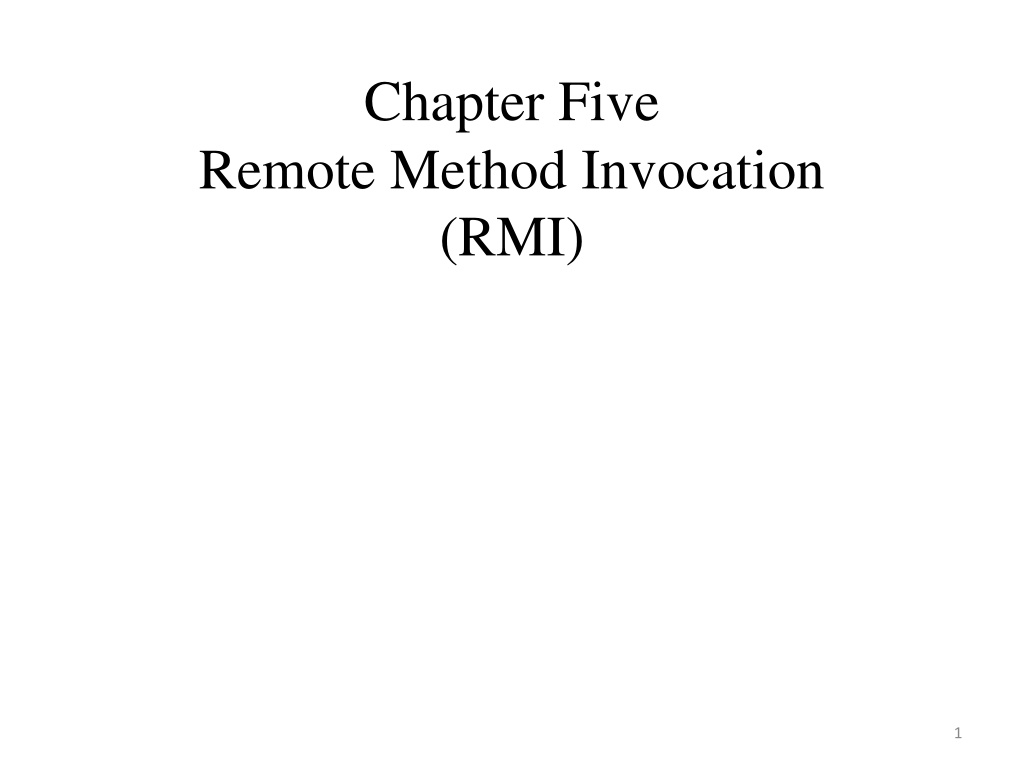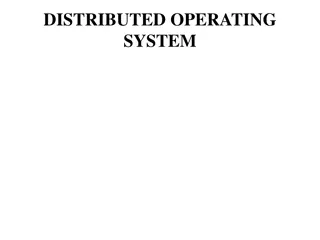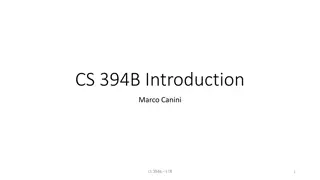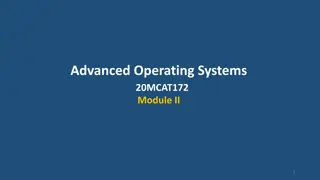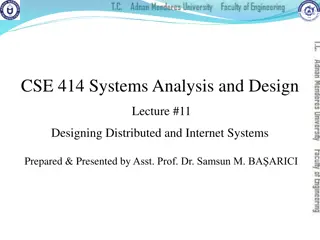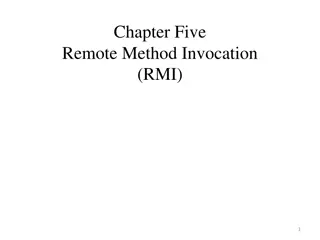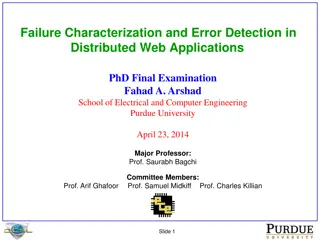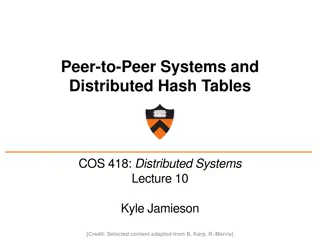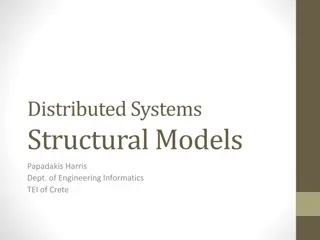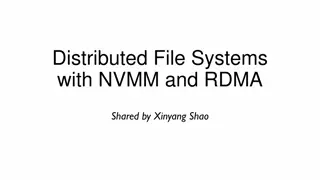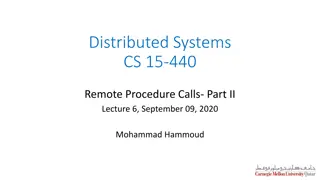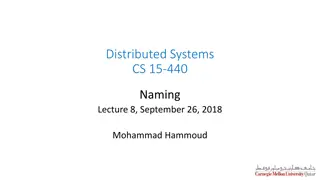Understanding Remote Method Invocation (RMI) in Distributed Systems
A distributed system involves software components on different computers communicating through message passing to achieve common goals. Organized with middleware like RMI, it allows for interactions across heterogeneous networks. RMI facilitates building distributed Java systems by enabling method invocation on remote objects, transparently handling data transmission across machines. Unlike RPC, RMI focuses on invoking methods within specific objects, making it an object-oriented approach for distributed computing.
Download Presentation

Please find below an Image/Link to download the presentation.
The content on the website is provided AS IS for your information and personal use only. It may not be sold, licensed, or shared on other websites without obtaining consent from the author. Download presentation by click this link. If you encounter any issues during the download, it is possible that the publisher has removed the file from their server.
E N D
Presentation Transcript
Chapter Five Remote Method Invocation (RMI) 1
What is Distributed System? A distributed system is a software system in which components located computers communicate and coordinate their actions by passing messages. The components interact with each other in order to achieve a common goal. on networked 2
Organization Distributed System To support heterogeneous computers and networks and to provide a single-system view, a distributed system is often organized by means of a layer of software called middleware that extends over multiple machines (RPC and RMI) A distributed system organized as middleware; note that the middleware layer extends over multiple machines 3
RMI Basics Remote Method Invocation (RMI) provides a framework for building distributed Java systems. Using RMI, a Java object on one system can invoke a method in an object on another system on the network. A distributed Java system can be defined as a collection of cooperative distributed objects on the network. RMI is the Java Distributed Object Model for facilitating communications objects. RMI is a higher-level API built on top of sockets. Socket-level programming allows you to pass data through sockets among computers. among distributed 4
RMI Basics RMI enables you not only to pass data among objects on different systems, but also to invoke methods in a remote object. Remote objects can be manipulated as if they were residing on the local host. The transmission of data among different machines is handled by the JVM transparently. 5
The Differences between RMI and RPC RMI is similar to Remote Procedure Calls (RPC) in the sense that both RMI and RPC enable you to invoke methods, but there are some important differences. With RPC, you call a standalone procedure. With RMI, you invoke a method within a specific object. RMI can be viewed as object-oriented RPC. 6
RPC vs RMI RPC (Remote Procedure Call) and RMI (Remote Method Invocation) are two mechanisms that allow the user to invoke or call processes that will run on a different computer from the one the user is using. The main difference between the two is the approach or paradigm used. RMI uses an object oriented paradigm where the user needs to know the object and the method of the object he needs to invoke. In comparison, RPC isn t object oriented and doesn t deal with objects. Rather, it calls specific subroutines or procedures that are already established. RMI: - The remote objects are accessed by the references. - Implements object to object implementation among different java objects to implement distributed communication model. - RMI passes the objects as parameters to remote methods. - RMI invokes the remote methods from the objects. RPC: - The process is through methods / functions. - Proxy server is involved in processing the procedure calls. - Calls a procedure remotely like invoking the methods. - The remoteness is not exactly transparent to the client. 7
The Differences between RMI and Traditional Client/Server Approach RMI is an evolution of the client/server architecture. A client is a component that issues requests for services, and a server is a component that delivers the requested services. Like the client/server architecture, RMI maintains the notion of clients and servers, but the RMI approach is more flexible. 8
The Differences between RMI and Traditional Client/Server Approach A RMI component can act as both a client and a server, depending on the scenario in question. A RMI system can pass functionality from a server to a client and vice versa. A client/server system typically only passes data back and fourth between server and client. 9
How Does RMI Work? Local objects are accessible only within the local host. Objects that are accessible from a remote host are called remote objects. For an object to be invoked remotely, it must be defined in a Java interface accessible to both the server and the client. Furthermore, the interface must extend the java.rmi.Remote interface. Like the java.io.Serializable java.rmi.Remote is a marker interface that contains no constants or methods. It is used only to identify remote objects. interface, 10
How Does RMI Work? The key components of the RMI architecture are listed below Server object interface: java.rmi.Remote that defines the methods for the server object. Server class: A class that implements the remote object interface. Server object: An instance of the server class. RMI registry: A utility that registers remote objects and provides naming services for locating objects. Client program: A program that invokes the methods in the remote server object. Server stub: An object that resides on the client host and serves as a surrogate for the remote server object. Server skeleton: An object that resides on the server host and communicates with the stub and the actual server object. A sub-interface of 11
How does RMI work? A subinterface of java.rmi.Remote that defines the methods for the server object. An object that resides on the client host and serves as a surrogate for the remote server object. An object that resides on the server host, communicates with the stub and the actual server object. Client Host Server Host Server Object Interface (4) Data Communication Server Object Interface A program that invokes the methods in the remote server object. Server Stub Server Skeleton An instance of the server object interface. Server Object Client Program (3) Return Server Stub RMI Registry Host (1) Register Server Object RMI Registry (2) Look for Server Object A utility that registers remote objects and provides naming services for locating objects. 12
How does RMI work? Java RMI uses a registry to provide naming services for remote objects, and uses the stub and the skeleton to facilitate communications between client and server. RMI works as follows: 1. A server object is registered with the RMI registry. 2. A client looks through the RMI registry for the remote object. 3. Once the remote object is located, its stub is returned in the client. 4. The remote object can be used in the same way as a local object. Communication between the client and the server is handled through the stub and the skeleton. 13
How does RMI work? The stub and the skeleton are automatically generated. The stub resides on the client machine. It contains all the reference information the client needs to know about the server object. When a client invokes a method on a server object, it actually invokes a method that is encapsulated in the stub. The stub is responsible for sending parameters to the server and for receiving the result from the server and returning it to the client. The skeleton communicates with the stub on the server side. The skeleton receives parameters from the client, passes them to the server for execution, and returns the result to the stub. 14
Passing Parameters When a client invokes a remote method with parameters, passing the parameters is handled by the stub and the skeleton. Obviously, invoking methods in a remote object on a server is very different from invoking methods in a local object on a client, since the remote object is in a different address space on a separate machine. Let us consider three types of parameters: 1. Primitive data types: A parameter of primitive type such as char, int, double, or boolean, are passed by value like a local call. 15
Passing Parameters 2. Local object types: A parameter of local object typesuch as java.lang.String, are also passed by value, but this is completely different from passing an object parameter in a local call. In a local call, an object parameter s reference is passed, which corresponds to the memory address of the object. In a remote call, there is no way to pass the object reference, because the address on one machine is meaningless to a different JVM. Any object can be used as a parameter in a remote call as long as it is serializable. The stub serializes the object parameter and sends it in a stream across the network. The skeleton deserializes the stream into an object. 16
Passing Parameters 3. Remote object types: Remote objectsare passed differently from local objects. When a client invokes a remote method with a parameter of a remote object type, the stub of the remote object is passed. The server receives the stub and manipulates the parameter through stub. 17
RMI Registry How does a client locate the remote object? The RMI registry provides the registry services for the server to register the object and for the client to locate the object. You can use several overloaded static getRegistry() methods in the LocateRegistry class to return a reference to a Registry, as shown in Figure (A) below. Once a Registry is obtained, you can bind an object with a unique name in the registry using the bind or rebind method or locate an object using the lookup method, as shown in Figure (B) below. 18
RMI Registry The LocateRegistry class provides the methods for obtaining a registry on a host. Figure (A) Figure (B) The Registry class provides the methods for binding and obtaining references to remote objects in a remote object registry 19
Developing RMI Applications The steps in developing an RMI application are shown in Figure below. 1 Define Server Object Interface 4 Create and Register Server Object 2 Define Server Implementation Class 5 Develop Client Program 3 rmic Server Stub Server Skeleton 20
Step 1: Define Server Object Interface 1. Define a server object interface that serves as the contract between the server and its clients, as shown in the following outline: public interface ServerInterface extends Remote { public void service1(...) throws RemoteException; // Other methods } A server object interface must extend the java.rmi.Remote interface. 1 Define Server Object Interface 4 Create and Register Server Object 2 Define Server Implementation Class 5 Develop Client Program 3 rmic Server Stub Server Skeleton 21
Step 2: Define Server Implementation Object 2. Define a class that implements the server object interface, as shown in the following outline: public class ServerInterfaceImpl extends UnicastRemoteObject implements ServerInterface { public void service1(...) throws RemoteException { // Implement it } // Implement other methods } The server implementation class must extend the java.rmi.server.UnicastRemoteObject class. The UnicastRemoteObject class provides support for point-to-point active object references using TCP streams. 1 Define Server Object Interface 4 Create and Register Server Object 2 Define Server Implementation Class 5 Develop Client Program 3 rmic Server Stub Server Skeleton 22
Step 3: Generate the Stub and Skeleton 3. Compile the server implementation class and use the following command to generate the skeleton and stub for the server implementation. rmic ServerInterfaceImpl The generated skeleton and stub are named ServerInterfaceImpl_Skeleton and ServerInterfaceImpl_Stub, respectively. 1 Define Server Object Interface 4 Create and Register Server Object 2 Define Server Implementation Class 5 Develop Client Program 3 rmic Server Stub Server Skeleton 23
Step 4: Create and Register Server Object 4. Create a server object from the server implementation class and register it with an RMI registry: ServerInterfaceImpl server = new ServerInterfaceImpl(...); Registry registry = LocateRegistry.getRegistry(); registry.rebind("RemoteObjectName", server); 1 Define Server Object Interface 4 Create and Register Server Object 2 Define Server Implementation Class 5 Develop Client Program 3 rmic Server Stub Server Skeleton 24
Step 5: Develop Client Program 5. Develop a client that locates a remote object and invokes its methods, as shown in the following outline: Registry registry = LocateRegistry.getRegistry(host); ServerInterface server = (ServerInterfaceImpl) registry.lookup("RemoteObjectName"); server.service1(...); 1 Define Server Object Interface 4 Create and Register Server Object 2 Define Server Implementation Class 5 Develop Client Program 3 rmic Server Stub Server Skeleton 25
Example: Retrieving Student Scores from an RMI Server Problem: This example creates a client that retrieves student scores from an RMI server. You can get the score by entering a student name and clicking the Get Score button. 26
Step 1: Define Server Object Interface 1. Create a server interface named StudentServerInterface. The interface tells the client how to invoke the server's findScore method to retrieve a student score. import java.rmi.*; public interface StudentServerInterface extends Remote{ /** * Return the score for the specified name * @param name the student name * @return a double score or 1 if the student is not found */ public double findScore(String name) throws RemoteException; } Any object that can be used remotely must be defined in an interface that extends the java.rmi.Remote interface. StudentServerInterface, extending Remote, defines the findScore method that can be remotely invoked by a client to find a student's score. Each method in this interface must declare that it may throw a java.rmi.RemoteException. Therefore your client code that invokes this method must be prepared to catch this exception in a try-catch block. 27
Step 2: Define Server Implementation Object 2. Create server implementation named StudentServerInterfaceImpl that implements StudentServerInterface. The findScore method returns the score for a specified student. This method returns -1 if the score is not found. import java.rmi.*; import java.rmi.server.*; import java.util.*; public class StudentServerInterfaceImpl extends UnicastRemoteObject implements StudentServerInterface { // Stores scores in a map indexed by name private HashMap<String, Double> scores = new HashMap<String, Double>(); public StudentServerInterfaceImpl() throws RemoteException { initializeStudent(); } /** Initialize student information */ protected void initializeStudent() { scores.put("John", new Double(90.5)); scores.put("Michael", new Double(100)); scores.put("Michelle", new Double(98.5)); } /** Implement the findScore method from the Student interface */ public double findScore(String name) throws RemoteException { Double d = (Double)scores.get(name); if (d == null) { System.out.println("Student " + name + " is not found "); return -1; } else { System.out.println("Student " + name + "\'s score is + d.doubleValue()); return d.doubleValue(); } } } 28
Step 2: Define Server Implementation Object The StudentServerInterfaceImpl class implements StudentServerInterface. This class must also extend the java.rmi.server.RemoteServer class or its subclass. RemoteServer is an abstract class that defines the methods needed to create and export remote objects. Often its subclass java.rmi.server.UnicastRemoteObject is used. This subclass implements all the abstract methods defined in RemoteServer. StudentServerInterfaceImpl implements the findScore method defined in StudentServerInterface. For simplicity, three students, John, Michael, and Michelle, and their corresponding scores are stored in an instance of java.util.HashMap named scores. HashMap is a concrete class of the Map interface in the Java Collections Framework, which makes it possible to search and retrieve a value using a key. Both values and keys are of Object type. The findScore method returns the score if the name is in the hash map, and returns -1 if the name is not found. 29
Step 3: Generate the Stub and Skeleton 3. Compile StudentServerInterfaceImpl.java to generate StudentServerInterfaceImpl.class. Use the JDK s rmic command to generate the skeleton from the server implementation as follows: C:\book\rmic StudentServerInterfaceImpl This command generates the two files named StudentServerInterfaceImpl_Skel.class and StudentServerInterfaceImpl_Stub.class. 1 Define Server Object Interface 4 Create and Register Server Object 2 Define Server Implementation Class 5 Develop Client Program 3 rmic Server Stub Server Skeleton 30
Step 4: Create and Register Server Object 4. Create a server object from the server implementation class and register it with an RMI registry. import java.rmi.registry.*; public class RegisterWithRMIServer { /** Main method */ public static void main(String[] args) { try { StudentServerInterface obj = new StudentServerInterfaceImpl(); Registry registry = LocateRegistry.getRegistry(); registry.rebind("StudentServerInterfaceImpl", obj); System.out.println("Student server " + obj + " registered"); } catch (Exception ex) { ex.printStackTrace(); } } } RegisterWithRMIServer contains a main method, which is responsible for starting the server. It performs the following tasks: (1) create a server object; (2) obtain a reference to the RMI registry, and (3) register the object in the registry. 31
Step 5: Develop Client Program 5. Create a client as an applet named StudentServerInterfaceClient. The client locates the server object from the RMI registry, uses it to find the scores. import javax.swing.*; import java.awt.*; import java.awt.event.*; import java.rmi.registry.LocateRegistry; import java.rmi.registry.Registry; public class StudentServerInterfaceClient extends JApplet { // Declare a Student instance private StudentServerInterface student; private boolean isStandalone; // Is applet or application private JButton jbtGetScore = new JButton("Get Score"); private JTextField jtfName = new JTextField(); private JTextField jtfScore = new JTextField(); public void init() { // Initialize RMI initializeRMI(); JPanel jPanel1 = new JPanel(); jPanel1.setLayout(new GridLayout(2, 2)); jPanel1.add(new JLabel("Name")); jPanel1.add(jtfName); 32
Step 5: Develop Client Program jPanel1.add(new JLabel("Score")); jPanel1.add(jtfScore); add(jbtGetScore, BorderLayout.SOUTH); add(jPanel1, BorderLayout.CENTER); jbtGetScore.addActionListener(new ActionListener() { public void actionPerformed(ActionEvent evt) { getScore(); } });} private void getScore() { try {// Get student score double score = student.findScore(jtfName.getText().trim()); // Display the result if (score < 0) jtfScore.setText("Not found"); else jtfScore.setText(new Double(score).toString()); } catch(Exception ex) { ex.printStackTrace(); } } 33
Step 5: Develop Client Program /** Initialize RMI */ protected void initializeRMI() { String host = ""; if (!isStandalone) host = getCodeBase().getHost(); try { Registry registry = LocateRegistry.getRegistry(host); student = (StudentServerInterface) registry.lookup("StudentServerInterfaceImpl"); System.out.println("Server object " + student + " found"); } catch(Exception ex) { System.out.println(ex); } } 34
Step 5: Develop Client Program /** Main method */ public static void main(String[] args) { StudentServerInterfaceClient applet = new StudentServerInterfaceClient(); applet.isStandalone = true; JFrame frame = new JFrame(); frame.setTitle("StudentServerInterfaceClient"); frame.add(applet, BorderLayout.CENTER); frame.setSize(250, 150); applet.init(); frame.setLocationRelativeTo(null); frame.setVisible(true); frame.setDefaultCloseOperation(3); } } 35
Step 5: Develop Client Program StudentServerInterfaceClient invokes the findScore method on the server to find the score for a specified student. The key method in StudentServerInterfaceClient is the initializeRMI method, which is responsible for locating the server stub. The initializeRMI() method treats standalone applications differently from applets. The host name should be the name where the applet is downloaded. It can be obtained using the Applet's getCodeBase().getHost(). For standalone applications, the host name should be specified explicitly. The lookup(String name) method returns the remote object with the specified name. Once a remote object is found, it can be used just like a local object. The stub and the skeleton are used behind the scenes to make the remote method invocation work. 36
Steps To Run the above Example 1. Start the RMI Registry by typing "start rmiregistry" at a DOS prompt from the you will run the RMI server. 2. Start the server RegisterWithRMIServer using the following command. Eg: C:\book>javac RegisterWithRMIServer.java C:\book>java RegisterWithRMIServer 1. Run the client StudentServerInterfaceClient as an application directory where NOTE: You must start rmiregistry from the directory where you will run the RMI server 37
RMI vs. Socket-Level Programming RMI enables you to program at a higher level of abstraction. It hides the details of socket server, socket, connection, and sending or receiving data. It even implements a multithreading server under the hood, whereas with socket-level programming you have to explicitly implement threads for handling multiple clients. RMI applications are scalable and easy to maintain. You can change the RMI server or move it to another machine without modifying the client program except for resetting the URL to locate the server. (To avoid resetting the URL, you can modify the client to pass the URL as a command-line parameter.) In socket-level programming, a client operation to send data requires a server operation to read it. The implementation of client and server at the socket-level is tightly synchronized. RMI clients can directly invoke the server method, whereas socket-level programming is limited to passing values. Socket-level programming is very primitive. Avoid using it to develop client/server applications. As an analogy, socket-level programming is like programming in assembly language, while RMI programming is like programming in a high-level language. 38
Developing Three-Tier Applications Using RMI Three-tier applications have gained considerable attention in recent years, largely because of the demand for more scalable and load-balanced systems to replace traditional two-tier client/server database systems. A centralized database system not only handles data access but also processes the business rules on data. Thus, a centralized database is usually heavily loaded because it requires extensive data manipulation and processing. In some situations, data processing is handled by the client and business rules are stored on the client side. It is preferable to use a middle tier as a buffer between a client and the database. The middle tier can be used to apply business logic and rules, and to process data to reduce the load on the database. A three-tier architecture does more than just reduce the processing load on the server. It also provides access to multiple network sites. This is especially useful to Java applets that need to access multiple databases on different servers, since an applet can only connect with the server from which it is downloaded. 39
Example: Retrieving Student Scores on a Database Using RMI Problem: This example rewrites the previous Example to find scores stored in a database rather than a hash map. In addition, the system is capable of blocking a client from accessing a student who has not given the university permission to publish his/her score. An RMI component is developed to serve as a middle tier between client and database; it sends a search request to the database, processes the result, and returns an appropriate value to the client. For simplicity, this example reuses the StudentServerInterface interface and StudentServerInterfaceClient class from previous example with no modifications. All you have to do is to provide a new implementation for the server interface and create a program to register the server with the RMI. Here are the steps to complete the program: 40
Example: Retrieving Student Scores on a Database Using RMI 1. Store the scores in a database table named Score that contains three columns: name, score, and permission. The permission value is 1 or 0, which indicates whether the student has given the university permission to release his/her grade. The following is the statement to create the table and insert three records: create table Scores (name varchar(20), score number, permission number); insert into Scores values ('John' , 90.5, 1); insert into Scores values ('Michael' , 100, 1); insert into Scores values ('Michelle' , 100, 0); 2. Create a new server implementation named Student3TierImpl in the following code. The server retrieves a record from the Scores table, processes the retrieved information, and sends the result back to the client. 41
Example: Retrieving Student Scores on a Database Using RMI import java.rmi.*; import java.rmi.server.*; import java.sql.*; public class Student3TierImpl extends UnicastRemoteObject implements StudentServerInterface { // Use prepared statement for querying DB private PreparedStatement pstmt; /** Constructs Student3TierImpl object and exports it on * default port. */ public Student3TierImpl() throws RemoteException { initializeDB(); } /** Constructs Student3TierImpl object and exports it on * specified port. * @param port The port for exporting */ public Student3TierImpl(int port) throws RemoteException { super(port); initializeDB(); } //Load JDBC driver, establish connection and create statement protected void initializeDB() { try { // Load the JDBC driver // Class.forName("oracle.jdbc.driver.OracleDriver"); 42
Example: Retrieving Student Scores on a Database Using RMI Class.forName("com.mysql.jdbc.Driver "); System.out.println("Driver registered"); // Establish connection /*Connection conn = DriverManager.getConnection ("jdbc:oracle:thin:@drake.armstrong.edu:1521:orcl ,"scott", "tiger"); */ Connection conn = DriverManager.getConnection "jdbc:mysql://localhost/javabook" , "scott", "tiger"); System.out.println("Database connected"); // Create a prepared statement for querying DB pstmt = conn.prepareStatement("select * from Scores where name = ?"); } catch (Exception ex) { System.out.println(ex); }} /** Return the score for specified the name Return -1 if score is not found.*/ public double findScore(String name) throws RemoteException { double score = -1; try { // Set the specified name in the prepared statement pstmt.setString(1, name); // Execute the prepared statement ResultSet rs = pstmt.executeQuery(); // Retrieve the score if (rs.next()) { if (rs.getBoolean(3)) score = rs.getDouble(2); }} catch (SQLException ex) {System.out.println(ex);} System.out.println(name + "\'s score is " + score); return score; } } 43
RMI Call Backs In a traditional client/server system, a client sends a request to a server, and the server processes the request and returns the result to the client. The server cannot invoke the methods on a client. One of the important benefits of RMI is that it supports callbacks, which enable the server to invoke the methods on the client. With the RMI callback feature, you can develop interactive distributed applications. 44
Example: Distributed TicTacToe Using RMI Example: Write a new distributed TicTacToe game using the RMI. See the full code in the Textbook. 45
The End!! 47
